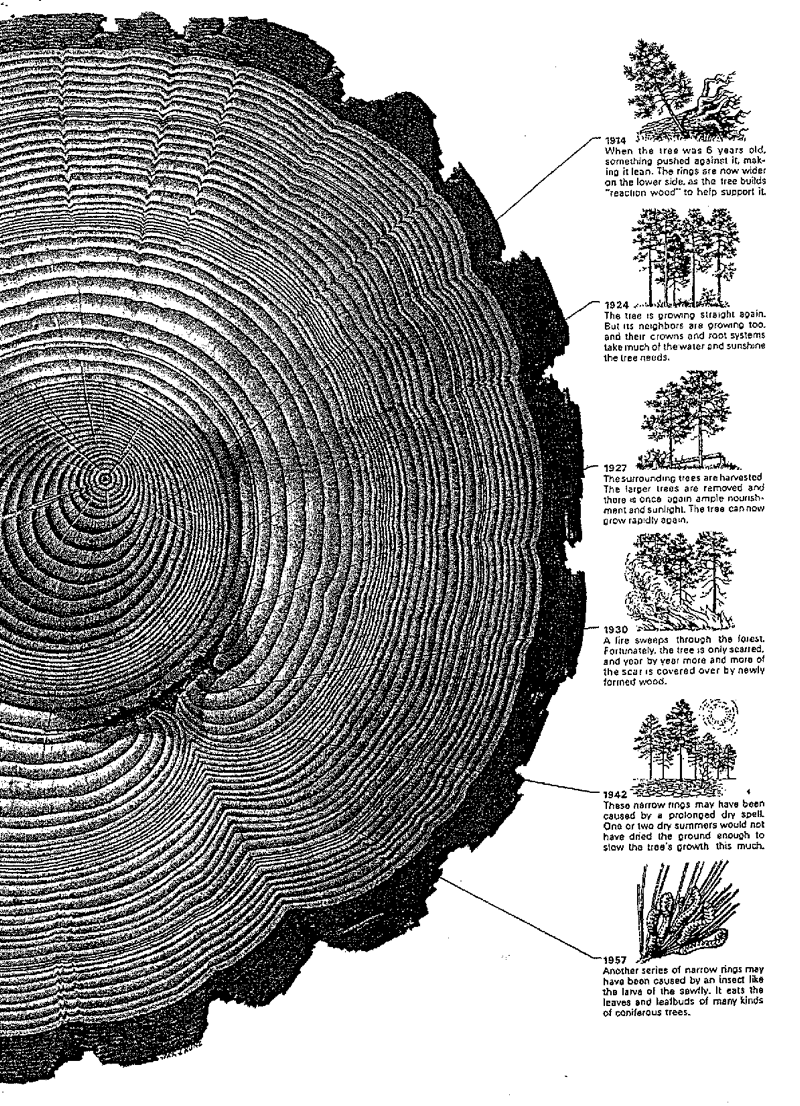Tree Rings:
Life Science: growth & environmental effects;
Practice:
Inquiry & processes: observation, evidence, & reasoning for explanations;
(3rd - 5th Grade)
Introduction
This investigational plan explores slices of trees, photos, and diagrams of tree rings to organize observational information as it relates to changes in tree growth as a result of weather and other environmental factors.
Related information and resources
- Tree ring activities for primary grades
- Reference materials for trees: leaf identification, bark, anatomy, twig anatomy
- Reference materials for plants: flowers, leaves, plant kingdom diagram, roots, activities, assessments
Concepts and outcomes
Content - Life science - Growth in trees
What we learn with science - enduring understanding, big ideas, generalizations
Life Science: Living & growth related to environmental factors
Animals consume energy and plants use sunlight to make their food. All living organisms use food for energy (metabolize), move, respire, use water, reproduce, respond to the environment (sensitivity), grow, excrete waste, require nutrition, and shelter. The quality of life, health of an organism depends on kinds of and amounts of environmental factors for the organisms that live there.
Related concepts and facts
- Living organism change and grow.
- Organisms can survive only in environments in which their needs can be met (animals need air, water, food, and shelter; plants need air, water, light, nutrients, and shelter)
- One ring per year, with the outer most ring telling the current growth story
- The only living part is in the outer ring
- Generally the larger the ring the better the climate conditions (sun, rain, temperature, wind) and other environmental factors (insects, disease, fire, lightning, humans)
- Smaller rings or abnormally shaped rings shows negative effects from: animals, disease, insects, fungi, fires, weather: flood, drought, lightening, wind, hail, tornadoes, erosion, ice, frost...
- Different environments provide different kinds of and amounts of environmental factors for the organisms that live there. One ring per year, with the outer most ring telling the current growth story
Outcome
Describe conclusions related to the basic needs of an organism being met or not met as they might relate to observed properties or characteristics of the organism as a result of its growth.
Specific outcomes -
- Describe a tree as living and changing as a result of its interactions with its environment.
- Describe tree rings as observable result of a tree's needs being met or not met.
Inquiry - processes
Constancy, change, measurement - variables relate to observable changes
How science inquires for understanding what stays the same, changes, and how to measure it.
Observed changes in properties can be attributed to changes of other variables and used to explain cause and effect for the observed change.
Related concepts and facts
- Observed changes can be described as changes of properties (variables).
- Variables are observations of a property that changes - size, shape, temperature, amount, volume, rate, ...
- When people disagree on an observation, they usually make more and better observations.
- Observation, creativity, and logical argument are used to explain how variable changes effect resulting observations.
Outcome
Describe change as a result of interactions. Describe those interactions as changes of a characteristic/ property (variable) that interacts with the object that changes.
Specific outcomes -
- Describe changes as a result of interactions (weather interacts with trees to change tree ring shapes).
- Describe interactions as changes of a characteristic/ property (variables) [(weather, climate, fire, animal, ...)] that interacts with the object [(tree)] that changes [(change the shape of the tree rings)].
Evidence, models, & explanation
How science explores and uses evidence to understand and explain.
Science or a scientist uses observable evidence to create an explanation.
Related concepts and facts
- Observed changes can be explained as being caused by changes of variables (changes of properties/ characteristics).
- Explanations are based on observations.
- Evidence is observation.
- Inference is an explanation based on observation.
- When people disagree on explanations, they can make more observations or change their explanation.
Outcome - processes - evidence, models, & explanation
Make observations of change, identify variables associated with the change, and create explanations of how the variables effect those changes.
Specific outcomes -
- Identify variables related to a change (that that effect tree ring growth).
- Relate variables to change with an explanation.
- Tree rings are evidence that can be used to explain (infer) the history of the tree's interactions with the environment over time.
Pedagogical ideas
Activity sequence
Possible Activity Sequence to provide sufficient opportunities for learners to attain the targeted outcomes.
- Characteristics of trees: Ask what effects different rates of tree growth and how those effects might be observed.
- Getting to know tree rings: Parts of a tree, there function, and Girdling
- The stories of rings: Observe different tree slices and their rings. Discuss how the rings are a record of a tree's history. Discuss what variables might create differences in rings and discuss what different shapes of rings might represent
- Discuss trees in the neighborhood, visit, take photographs...
- Age of trees without looking inside: How to determine a twig's age with external observation
- Tree rings might suggest how to protect the environment
Focus questions:
- What is living?
- How are living organisms effected by the environment?
Scoring guides
Low level: Describes a tree ring as circular marks on trees.
Middle level: Describes tree rings as being inside a tree and can be counted to tell how old a tree is. May describe two rings for each year or other inaccurate procedure for determining age.
Upper level: Tree rings represent the quality of life the tree had during each year of growth. The quality of life being representative of the environmental factors that are necessary and sufficient for growing well. Singular events or long term events can influence a ring, indicating a short term event or a range of rings can describe an event with a lasting influence or an event for an extended period of period.
Activities
Exploration Activities:
Activity: Characteristics of trees
Materials: Lab notes
Suggested procedure:
Have learners answer the following questions in their lab notes as a pre activity:
- Make a list of properties or characteristics of trees.
- What characteristics of trees can be used to represent growth?
- What variables could cause a tree to grow differently and how would it effect the growth?
- Create a list of variables that might affect tree growth, describe the effect it might have, and how it might be observed.
Materials: tree trunk slices from different trees and different slices from the same tree, magnifying glasses, rulers, weather records
If you can get multiple slices from the same tree or slices from different trees that lived part of their lives during the same time frames so students can match ring patterns. Slices can be cut into pie shaped pieces so they can be used by more groups and can also be lined up with other slices to compare side by side.
Suggested procedure:
Students probably identified tree rings as one of the properties of trees (If they did not mention tree rings, call it to their attention). Tell them to focus on them and explore the tree trunk slices and think about the following questions and discuss them as they observe the tree slices and look for evidence to support their ideas. Then, summarize the ideas in the table.
- Do all plants have rings?
- What are tree rings?
- What can we learn from the rings?
- What do they represent?
- How are tree rings made?
- Are they different and if so, why?
| Variables that affect tree growth | How could the variable help the tree grow better or negatively affect growth? | What evidence might there be in a growth ring? |
|---|---|---|
| 1 | ||
| 2 | ||
| 3 | ||
| 4 | ||
| 5 | ||
| 6 |
- Ask student if they can think of what evidence might be available to know how these different variables affected the tree?
- Do you think there is evidence that could be used to know the history of how a tree grew over the years it was alive?
Invention Activities:
Activity: Getting to know tree rings
Materials: actual tree ring slices, pictures and diagrams of tree rings, girdling tree story, Climate and the Khan article.
Activity procedure:
Review the answers to the questions from the exploration activities:
- Ask student if they can think of what evidence might be available to know how these different variables affected the tree?
- Do you think there is evidence that could be used to know the history of how a tree grew over the years it was alive?
To help students understand that tree rings grow from the outside share and discuss the girdling story:
Story of Girdling trees.
The forest was ideal for farming because it had the best soil. That meant it had to be cleared. Men and women cleared the land. A common method was to clear the undergrowth with a scythe, cut down all trees that had a diameter of eighteen inches or less, and kill larger trees by girdling them with an ax. Once they were killed the leaves wouldn't block the sun and they wouldn't use water or other nutrients, leaving them for the crops that would be planted among the skeletons. Later the dead trees could be burnt or left to rot.
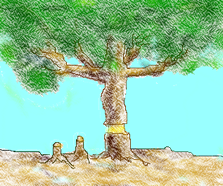
Have students identify different parts of the cross section and label them in their lab book. They can use the information from the Girdling story and other sources to label the: heartwood, sapwood, annual growth rings, smallest growth ring, largest growth ring, most rapidly grown ring, slowest grown ring, and environmental effects.
Activity: The stories of rings
Show students cross-sections of trees or pictures and diagrams and discuss the following:
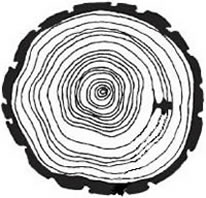
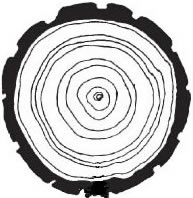
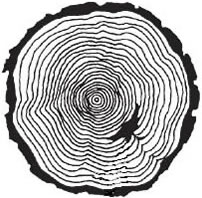
- Observe and describe similarities and differences among rings and groups of rings.
- Identify different parts of the tree and label - heartwood, sapwood, annual growth rings, smallest growth ring, largest growth ring, infer most rapid growth ring, infer slowest ring, and infer environmental effects.
- Explain how the irregularities might match different events.
- Ask student if they can think of what evidence might be available to know how the different variables affected the tree?
- Ask if there is evidence that could be used to know the history of how a tree grew over the years it was alive?
Problems or challenges
- Determine average ring width (measure or other...?).
- Use a limb that has been cut into several pieces and challenge students to put it in order as it was before it was cut.
- Are there differences in trees that can be found in the same location? And if so why?
- Make a two classification system that describes at least two kinds of growing years - good and not good.
Activity: Differences of trees in the neighborhood: around home, school, park, or other areas.
Find and use pictures of different trees or their cross-sections to show how the life of the tree has created different growth rings and is a history of the environmental influences on the tree during its life.
Activity: Age of trees without looking inside
Have students observe twigs and discuss how to determine how old each is. (look for annual growth rings and discuss how this observation could suggest how specific environmental factors varied to result in the observations.)
Discover or application extension
Activity: Tree rings might suggest how to protect the environment
Materials: pictures and article or article summary for trees
Climate and the Khan by Russ Juskalian Discover Magazine July/August 2015
The article describes how Amy Hessl lead a team to Mongolia and collected tree rings that dated to the time of Chinggis (Genghis) Kahn. The rings suggest an abnormally wet period during the time Chinggis expanded the Mongolian Empire and suggests dry is more usual than wet. The article also presents evidence the warming of the climate caused another increase in wet weather in the later part of the 1900's, which greatly lead to an expansion of the population as result of better grazing for herds of animals in Mongolia. However, after 2000 the more usual drier climate returned and has been devastating to agriculture. Resulting in deterioration of land, selling off of livestock herds, and the emigration of the population to urban areas. The story is similar to the America west during the dust bowl era.
How can science help to understand the climate and make better decisions?
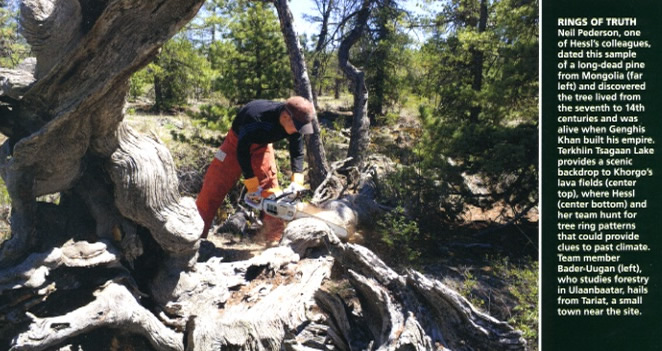
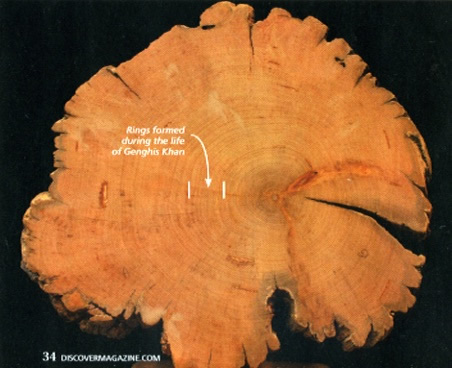
Suggested procedure:
- Discuss how the evidence from the Mongolian tree rings is important for the Mongolians and the rest of the world.
- Discuss if it would have helped the country if the information would have been known or available 30 years ago?
- Discuss how the use of scientific information informed their answers.
![]()
Lab Notes
Activity: Characteristics of trees
1. List properties or characteristics of trees.
2. Which properties of trees can be used to represent growth?
3. What variables could cause a tree to grow differently and how would it effect the growth?
4. Create a list of variables that might affect tree growth, describe the effect it might have, and how it might be observed.
Materials: Tree trunk slices from different trees and different slices from the same tree, magnifying glasses, rulers, weather records,
Think about and discuss the following questions. Observe the tree slices and look for evidence that can sport your ideas. Then, summarize the ideas in the table.
- Do all plants have rings?
- What are tree rings?
- What can we learn from the rings?
- What do they represent?
- How are tree rings made?
- Are they different and if so, why?
| Variables that affect tree growth | How could the variable help the tree grow better or negatively affect growth? | What evidence might there be in a growth ring? |
|---|---|---|
| 1 | ||
| 2 | ||
| 3 | ||
| 4 | ||
| 5 | ||
| 6 |
Activity: Getting to know tree rings
Use the information from the Girdling story and other sources to label the diagram: Include: heartwood, sapwood, annual growth rings, smallest growth ring, largest growth ring, most rapidly grown ring, slowest grown ring, and environmental effects.
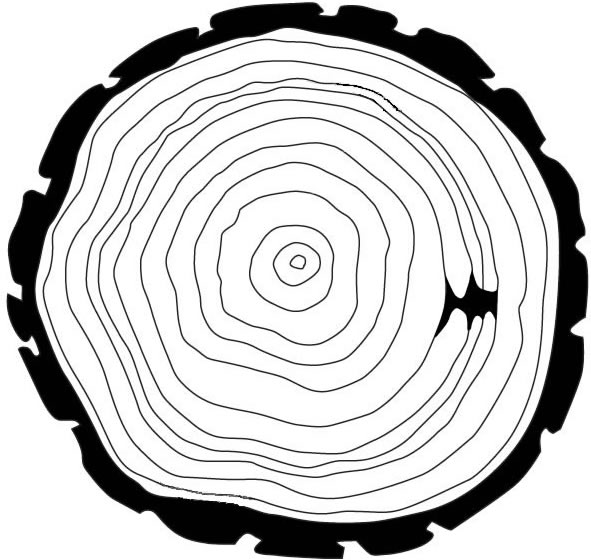
Activity: The stories of rings
Summarize the answers to the questions discussed in class in the chart below:
| Variables that affect tree growth | How could the variable help the tree grow better or negatively affect growth? | What evidence might there be in a growth ring? |
|---|---|---|
| 1 | ||
| 2 | ||
| 3 | ||
| 4 | ||
| 5 | ||
| 6 |
Activity: Age of trees without looking inside
How are twig growth rings alike and different than cross section growth rings?
Activity: Tree rings might suggest how to protect the environment
How might the evidence from the Mongolian tree rings have helped the country if the information would have been known or available 30 years ago?
What did you use scientific information to inform your answer?
Tree rings
